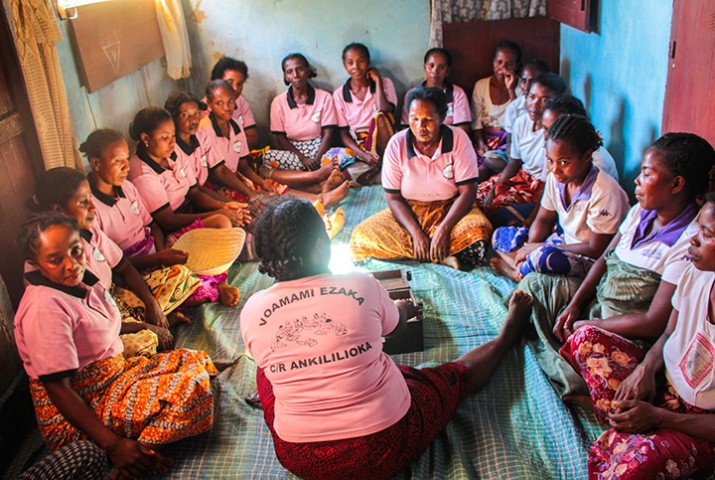Building Self Reliance through Savings and Loans Communities
Building Self Reliance through Savings and Loans Communities
Story and photos by Samy Rakotoniaina and Alison Baggen

A Step Toward Universal Health Coverage in Madagascar
In rural Madagascar, people have limited access to savings programs or credit. This impacts community health when people cannot afford to pay for health care. In partnership with Catholic Relief Services (CRS), the USAID Mikolo Project promoted the creation of savings and internal lending communities (SILCs) at the Fokontany (village) level to encourage individuals and families to regularly save income and to provide them with access to credit on favorable terms.
CRS first developed the SILC approach for general community development, and USAID Mikolo implemented it for the first time in the field of public health. SILC groups offer easy access to financial services for households and health care providers, especially women, as well as social capital. The main objective of SILCs is to provide funding, borrowing, and savings opportunities for community members.
![[SILC group members in Vohipeno, Vatovavy Fitovinany Region, wait for their weekly meeting to start.]](https://msh.org/wp-content/uploads/2018/06/silc_2-web-720px.jpg)
SILCs are groups of 15-25 community members that meet on a weekly basis. Each member contributes money into the SILC fund. Members can borrow money at a fixed interest rate, e.g. to start up a small business. After a full cycle (9-12 months), the total savings accrued throughout the period are distributed to members based on how much each has saved, as a percentage of the overall savings.
![[A designated SILC secretary counts the weekly contribution.]](https://msh.org/wp-content/uploads/2018/06/silc_3-web-716px.jpg)
Two types of funds are saved within SILCs: community and social. Community contributions are collected weekly from each member. At the beginning of each cycle, each group decides how much each member can contribute to the fund. Individual contributions typically vary from 500-2,500 Ariary a week (US$ 0.3- US$1). Members may take out loans from this fund, at an interest rate decided by the group, in order to partake in revenue-generating activities, like buying long on rice. The loan, which can be up to three times what the member has saved, must be approved by all group members, and the money must be repaid within three months with interest.
![[The designated SILC secretary informs the group about the total savings of each member.]](https://msh.org/wp-content/uploads/2018/06/edited-4_716.png)
Members also contribute to a social fund each week, with a minimum amount decided upon by the group. Members can take out a zero-interest loan or grant from this social fund for an unexpected event, such as a family medical emergency or other health needs.
![[SILC materials such as record-keeping books and cash pouches are simple and affordable.]](https://msh.org/wp-content/uploads/2018/06/silc_5-web-720px.jpg)
The tools (initially provided by USAID Mikolo) and financial contributions of members are stored in a wooden box. In addition a calculator, pen, stamp with ink, record-keeping books, and a large notebook are provided to the group for fund calculations. The group also uses two cloth cash pouches–one for the social fund and one for the community fund.
![[ A SILC secretary records the weekly collection for the group.]](https://msh.org/wp-content/uploads/2018/06/silc_6-web-720px.jpg)
Each group has a secretary and a president; the secretary is responsible for collecting each member’s money and keeping the records up to date. The president ensures that rules are followed and that everybody is treated equally. There are also three treasurers holding the three different keys of the wooden box where the cash money is kept, which ensure security.
![[Jean Lardo (left), a private service provider, supports a SILC group in Vohipeno, south-east of Madagascar.]](https://msh.org/wp-content/uploads/2018/06/edited-7_716px.png)
The project recruited and trained field agents to strengthen the promotion of SILCs at the local level. After one year of service, successful field agents were certified to become private service providers who continued the promotion on their own because they are paid by the groups they visited or supported. The private service providers also encourage lifestyle changes and development with financial education. For example: purchasing farm animals for higher returns in the future; buying seeds to grow food, refurbishing homes and community spaces to improve indoor air quality and protect them against cyclones; building latrines to improve sanitation; and purchasing school supplies for children.
![[A Community Health Volunteers monitors the growth of child during a home visit.]](https://msh.org/wp-content/uploads/2018/06/untitled_design_1_0.jpg)
This idea of SILC groups is not new to Madagascar; however, what makes the USAID Mikolo model unique is that the underlying premise is that rural development is inherently connected with health. USAID Mikolo-supported SILC groups enable members to both improve their livelihoods and lead healthy lives.
In fact, community health volunteers (CHVs) participate in the SILC groups not only as members, but also as health educators to improve quality of life by considering personal and family health. Life in a rural village is very difficult, and without financial stability simple healthy behaviors may seem out of reach for many families, such as purchasing needed medicines, soap, family planning methods, or healthy food. CHVs encourage these behaviors, and with the SILC program these and other health-promoting activities can become regular habits rather than unattainable conventions.
![[ A mother asks a SILC group for a loan to pay for the treatment of her sick baby.]](https://msh.org/wp-content/uploads/2018/06/silc_9-web-715px.jpg)
Men, women, and youth alike participate in SILC groups. Often, all community members are encouraged to join a specific, local group, depending on location, but the USAID Mikolo Project especially promotes female participation to develop empowerment. To date, 70% of the 60,000+ SILC group members in the project’s intervention areas are female.
![[ The weekly collection of a SILC group before being recorded by the secretary and locked inside the wooden box.]](https://msh.org/wp-content/uploads/2018/06/silc_10-web-725px.jpg)
The USAID-funded Mikolo Project has successfully supported the establishment of SILC groups in its intervention areas as a mechanism to contribute to improved access to basic health care services and promote care-seeking behavior. A total of 2,599 groups were established, and they accrued the equivalent of nearly USD $700,000 in savings. The Ministry of Public Health is currently looking for ways to integrate the SILC concept into Madagascar’s Universal Health Coverage scheme.